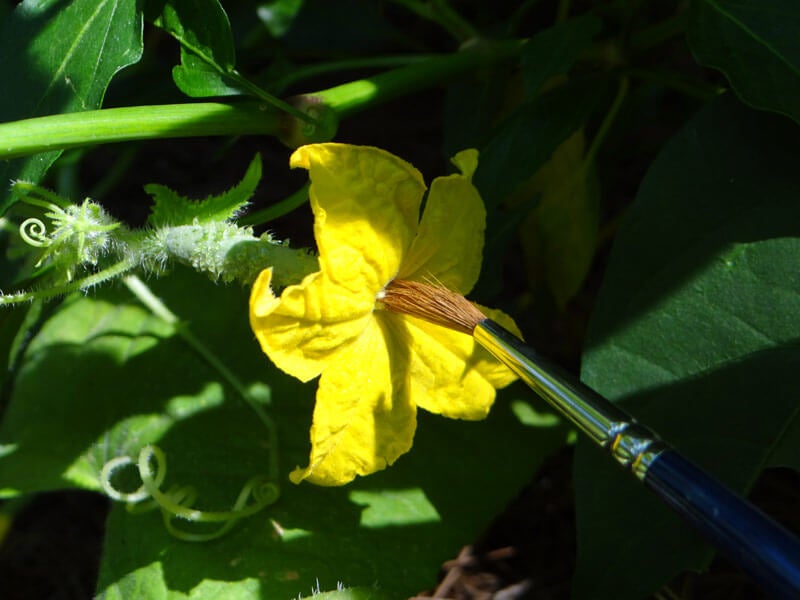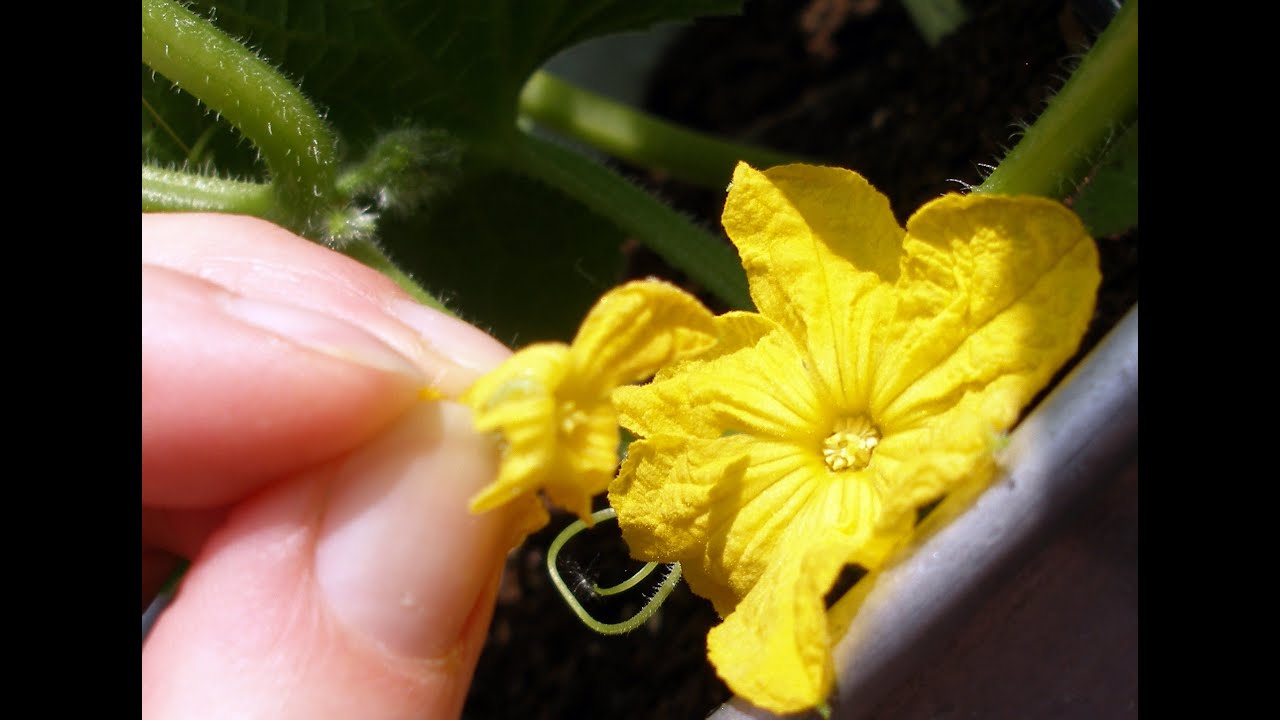To self-pollinate cucumbers, transfer pollen from the male flower to the female flower using a small brush or cotton swab. Cucumbers can be self-pollinated by manually transferring pollen from the male flower to the female flower, ensuring successful fruit production.
By following this simple process, gardeners can ensure a bountiful harvest of cucumbers. Self-pollination can be done easily with a small brush or cotton swab, gently transferring pollen from the male flower to the stigma of the female flower. This ensures that the female flower is fertilized and results in the formation of cucumbers.

Credit: bonnieplants.com
Self-pollinating cucumbers is a straightforward technique that home gardeners can employ to guarantee an abundant cucumber harvest.
Benefits Of Self Pollinating Cucumbers
Self pollinating cucumbers offer several benefits, including increased yield and fruit production. By self pollinating, these cucumbers are able to ensure a stable food supply as they do not rely on external pollinators. This is especially beneficial in areas with limited access to pollinators or during periods of low pollinator activity. With self pollination, cucumber plants can produce more fruits, leading to a higher overall yield.
Another advantage of self pollination is the promotion of genetic diversity in cucumber varieties. It allows for the natural crossing of different cucumber plants, leading to the development of new hybrids with unique characteristics. This helps to maintain a diverse gene pool, which is essential for the long-term health and adaptability of cucumber crops.
How to Self Pollinate Cucumbers : Step by Step Guide
Understanding The Basics Of Cucumber Pollination
Understanding the Basics of Cucumber Pollination is crucial for gardeners aiming to self-pollinate cucumbers. Pollination plays a vital role in cucumber plants as it enables the transfer of pollen grains from the male to the female flowers, leading to fruit formation.
Cucumbers have both male and female flowers. Male flowers have stamens that produce pollen grains, while female flowers have a stigma that receives the pollen. This transfer of pollen between flowers is usually done by bees and other insects.
These insects are attracted to the bright yellow color of the male flowers and collect pollen as they move from flower to flower. When they visit a female flower, some of the collected pollen rubs off onto the stigma, initiating the pollination process. This fertilization ensures proper fruit development.
Therefore, it is important to encourage bee and insect activity in your garden by planting nectar-rich flowers nearby. By understanding the significance of pollination and the role of bees, gardeners can successfully self-pollinate cucumbers and enjoy a bountiful harvest.
Identifying The Need For Self Pollination
Self pollination is an important technique for cucumber plants, especially when natural pollination is hindered. There are various factors that can affect natural pollination, leading to poor pollination in cucumber plants. By identifying the signs of poor pollination, gardeners can take steps to ensure successful self-pollination.
Poor pollination in cucumber plants can be observed through certain signs. These signs include low fruit set, misshapen or deformed fruits, and flowers dropping off the plant prematurely. Factors such as lack of pollinators, extreme temperatures, rainy weather, or high humidity can hinder natural pollination. In such cases, self pollination can come to the rescue.
Self pollination involves transferring pollen from the male flowers to the female flowers manually. The best way to do this is by using a small brush or a cotton swab. Gently transfer the pollen from the stamen of the male flower to the stigma of the female flower. Repeat this process every day during the flowering period to ensure proper pollination.
How To Self Pollinate Cucumbers
Cucumbers are a popular vegetable to grow in home gardens, and self pollination can be a useful technique to ensure a successful harvest. The first step in self pollinating cucumbers is identifying the male and female flowers. Male flowers have a thin stem and no swelling at the base, while female flowers have a small cucumber shape at the base.
Once you have identified the flowers, you can transfer pollen from the male to the female flowers. This can be done by gently brushing the stamen of the male flower against the stigma of the female flower. To maximize pollination success, timing is important. Make sure the flowers are open and receptive before attempting to transfer pollen.
Additionally, using a pollination brush can help ensure precise pollen transfer. However, it is important to avoid over-pollination, as this can result in misshapen cucumbers. With these steps in mind, you can successfully self pollinate cucumbers in your garden.
Ensuring Successful Pollination
Successful pollination is crucial for a bountiful cucumber harvest. To ensure self-pollination, creating a suitable environment is key. One common mistake is overlooking the important relationship between temperature and humidity. Cucumbers thrive in warm conditions with a humidity level around 60-70%. Maintaining these conditions helps pollen stick to the stigma effectively.
In greenhouse settings, pollination can be more challenging due to limited airflow. Overcome this by gently shaking the cucumber plants to disperse the pollen. Another option is to use a small brush to transfer pollen from the male flowers to the female flowers. Remember to avoid touching the flowers directly to prevent damage. Correcting these challenges will greatly enhance the pollination process, resulting in a healthy cucumber crop.
Post-Pollination Care For Cucumber Plants
After self-pollinating your cucumber plants, it is crucial to provide proper post-pollination care for their healthy growth.
Identifying successful pollination: Check for the presence of small cucumbers, about the size of your thumbnail, within a week after pollination. These indicate that pollination was successful.
Caring for the developing fruits: Make sure the cucumbers are well-supported by adding trellises or stakes. This helps prevent stress on the vines and ensures proper fruit development.
Providing adequate nutrients and moisture: Regularly water the plants to keep the soil evenly moist, but avoid overwatering, as wet conditions can lead to fungus and rot. Use a balanced fertilizer to provide necessary nutrients, following the recommended dosage.
Protecting against pests and diseases: Monitor the plants closely for any signs of pests or diseases. Apply organic pest control methods if required and regularly inspect the leaves and vines for any issues.
Incorporating these post-pollination care practices will significantly improve the yield and overall health of your cucumber plants.
Additional Tips For Cucumber Pollination
When it comes to self-pollinating cucumbers, there are some additional tips that can help ensure a successful outcome. One effective method is to use companion planting to attract pollinators to your garden. By planting flowers such as marigolds, lavender, or sunflowers near your cucumber plants, you can entice bees, butterflies, and other beneficial insects to visit.
This will enhance the overall biodiversity of your garden, creating a more sustainable and productive ecosystem. Additionally, providing a variety of flowering plants throughout the growing season can help maintain a consistent source of nectar and pollen for pollinators. Moreover, avoiding the use of harmful pesticides and opting for organic and natural alternatives can further support these crucial garden visitors. Creating a welcoming habitat for pollinators will ensure that your cucumber plants receive the necessary cross-pollination, leading to improved fruit set and higher yields.
Frequently Asked Questions For How To Self Pollinate Cucumbers
How Often Do You Hand Pollinate Cucumbers?
Cucumbers should be hand pollinated every day to ensure proper fruit development.
How Do You Know If A Cucumber Flower Is Male Or Female?
To determine if a cucumber flower is male or female, look for a tiny cucumber at the base.
Why Do My Cucumbers Have Flowers But No Cucumbers?
Cucumbers often have flowers but no cucumbers due to a lack of pollination.
What Are The Best Pollinators For Cucumbers?
Honey bees and bumblebees are the best pollinators for cucumbers.
Conclusion
Self-pollinating cucumbers can be a rewarding experience for any gardener. By understanding the process and following the steps outlined in this blog post, you can enjoy a bountiful cucumber harvest even without the help of bees or other pollinators. Remember to identify the male and female flowers, transfer the pollen carefully, and provide the right conditions for successful pollination.
It is important to stay patient and observant throughout the process, as cucumbers may take several attempts to properly self-pollinate. With a little practice and attention to detail, you can ensure a higher success rate and a healthier cucumber crop.
So, go ahead and try your hand at self-pollinating cucumbers, and enjoy the satisfaction of growing your own delicious, homegrown cucumbers. Happy gardening!

